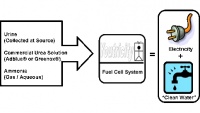Dr Shanwen Tao and his research partner Dr Rong Lan have developed a prototype, the Carbamide Power System, and have now been awarded a £130,000 EPSRC grant to develop it.
Fuel cells convert chemical energy into electricity via an electrochemical process. Traditional fuel cells usually involve hydrogen or methanol at one side and oxygen or air at the other, separated by a specialised ionic-conducting membrane.
According to Heriot-Watt, the biggest obstacles to commercialising these proton exchange membrane (PEM) fuel cells are cost, with the membrane and conventional, platinum-based catalysts, and challenges involving the transportation and storage of the highly flammable hydrogen or the toxic methanol.
The Carbamide Power System involves far cheaper membrane and catalysts, and can be run on urea (also known as carbamide) − a mass-manufactured industrial fertiliser and a major component of human and animal urine.
Carbamide Power Systems would reportedly offer a non-toxic, low-cost, easily transportable, viable alternative to high-pressure, highly flammable hydrogen gas or the methanol currently used in fuel cells. As urea solution is increasingly being used in heavy goods vehicles to reduce nitrous-oxide emissions, a global fuelling infrastructure already exists.
Dr Tao believes that long-term potential applications of the Carbamide Power System include submarines and power generation in isolated or remote areas. As the process breaks the urea or urine into water, nitrogen and carbon dioxide, it could also be used to reprocess waste water, with electricity as a byproduct.
Dr Tao said: ‘We are only at the prototype stage at present, but if this renewable material can be used as a commercially viable and environmentally friendly energy source then we will be absolutely delighted and many people around the world will benefit.’






Glasgow trial explores AR cues for autonomous road safety
They've ploughed into a few vulnerable road users in the past. Making that less likely will make it spectacularly easy to stop the traffic for...